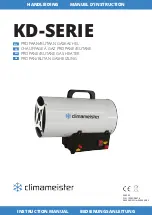
9
HIGH ALTITUDE
Water heaters covered in this manual have been tested
and approved for installation at elevations up to 7,700
feet (2,347 m) above sea level. For installation above
7,700 feet (2,347 m), the water heater’s Btu input should
be reduced at the rate of 4 percent for each 1,000 feet
(305 m) above sea level which requires replacement of
the burner orifice in accordance with the National Fuel
Gas Code ANSI Z223.1/NFPA 54 or the Natural Gas and
Propane Installation Code CAN/CSA B149.1. Contact
your local gas supplier for further information.
Failure to replace the standard orifice with the proper
high altitude orifice when installed at elevations above
7,700 feet (2,347 m) could result in improper and
inefficient operation of the water heater, producing
carbon monoxide gas in excess of the safe limits. This
could result in serious injury or death. Contact your
local gas supplier for any specific changes that may be
required in your area.
ADJUSTING AIR SHUTTER FOR HIGHER ALTI-
TUDES
The air shutter is preset with the air shutter in the open
position and for most applications changing the air
shutter is not required.
FIGURE 2. AIR SHUTTER OPEN
A correctly set burner should have a stable quiet flame.
The flame will be blue with a well defined blue inner
flame, Some yellow tipping is normal with LP gas. See
FIGURE 3. NORMAL FLAMES
If flames are seen to lift from the burner ports, gradually
close the air shutter until a stable flame is achieved. See
FIGURE 4. FLAME LIFTING
for the appearance of the half-closed and
full-closed air shutter. Normally, this flame lifting occurs
only at altitudes above 5,400 feet.
FIGURE 5. HALF-CLOSED AND CLOSED AIR SHUTTER
If the air shutter is closed too far, the flame will look hazy
and not have defined cones. See the example in
(page 10). In this case, the air shutter will need to be
opened. See
.
Summary of Contents for BT-100-LP
Page 45: ...45 NOTES ...
Page 47: ...47 ...










































